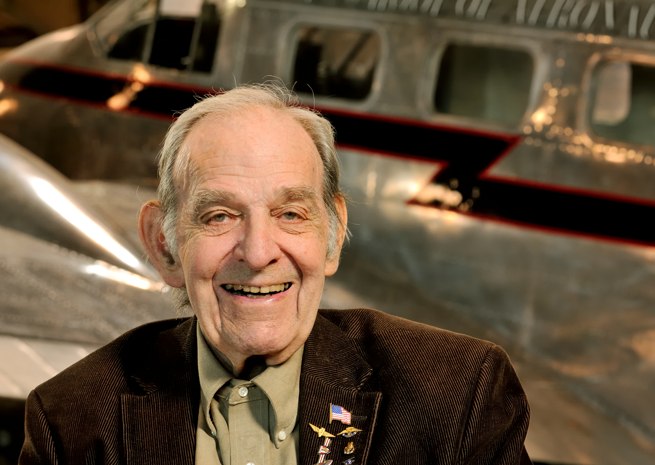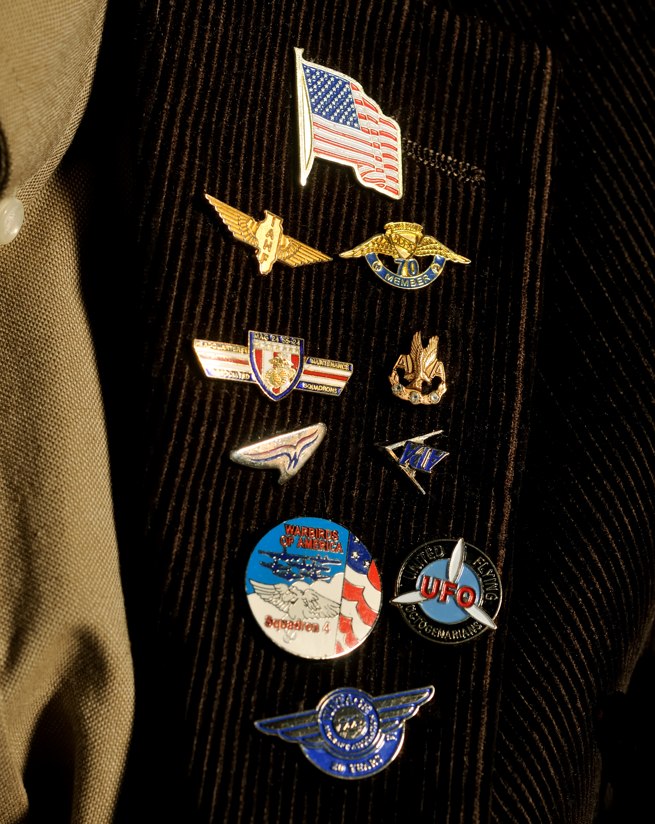
Clarence A. “Clancy” Hess, 92, of Lockport, Ill., earned his nickname in the Marine Corps. “I managed to leave a bomb in a Japanese ship that had a big boom. There was a popular song back in those days, ‘Clancy, Lower the Boom’—they saw the ship capsize and the boom went in the water, so that’s been my nickname ever since.
“It’s been a real interesting lifetime,” he said. “I grew up on a farm in what is now known as Skokie, Illinois. My folks started as immigrants from Luxembourg, in Europe, and when they arrived in Chicago they had the background of working in greenhouses. They built the first greenhouse in all of Chicagoland to grow vegetables for the markets. Our cousins had a farm to the west of us, at the site which is now O’Hare Airport’s control tower location, and we spent many a Sunday morning milking cows over there, on Sundays particularly.”
With Charles Lindbergh’s successful flight to Paris, Hess said, every community wanted to have an airport. “An airport in those days could be a usable pasture with a windsock. Our closest neighbors, the Myers family—Louie Myers, the race car driver—he was so taken up with Charlie Lindbergh, he bought one of the first Waco 9s. Starting in 1928, he was taking me for airplane rides with him, out of their pasture, so early on I figured out what a stick and rudder bar did in an airplane.
“In 1930 the National Air Races were brought to Chicago. My dad had taken me to Cleveland in 1929 to visit with some remote cousins whose farm was across the street from the Cleveland airport.” Hess said his father, a carpenter, helped build the first structure at Curtis Reynolds Airport—conceived as an aviation country club, it later became Glenview Naval Air Station—and coordinated the construction of grandstands when the airport hosted the races.
When some of the top race pilots of the day—men like Art Chester from Joliet, Ill., and Johnny Livingston from Waterloo, Iowa—began arriving in Glenview, which was remote at the time, Hess said they prepared to camp under their wings. “My dad saw heavy weather coming in and invited them to come to our house,” which frequently accommodated farm workers and had beds for 16 people. “When they arrived, I can still remember how pleased they were, because he’d been a stubborn Luxembourger and had a whole basement full of good home brew.”

The races lasted 10 days, and some of those pilots overnighted the whole time at the Hess residence. “Even Jimmy Doolittle was there. Charlie Lindbergh came by one evening and had dinner.” And Livingston became friendly with Hess’s parents “He’d come visit every once in a while, because he’d set up selling Wacos and Monocoupes at the airport in Aurora, not that far away.
“On my tenth birthday he showed up and had breakfast with us,” Hess recalled, and then they went flying in Livingston’s Velie Monocoupe. “He kept asking me questions or telling me stuff about what airplanes were about, and later my dad told me I interrupted him a few times because I already knew that stuff,” Hess laughed. “He put me up in the left seat. The only thing on the instrument panel was a tachometer and an oil pressure gauge. He says, ‘Well, you’ve been telling me stuff about airplanes, now show me!’ I just taxied around for a while. We had already talked about going around and coming in for a landing, and we did just that. This went on for an hour and 45 minutes. Then he got out and said, ‘Go fly it, kid,’ so I am as far as I can determine the first to be soloed on my tenth birthday.”
During the Depression, Hess’ family moved to a farm in Iowa, and after school he would hitchhike to the airport in Dubuque or Waterloo, Iowa. “I’d frequently wind up over there with Johnny Livingston. Johnny had become one of the first trying to sell Taylorcrafts—they were the 40-horse ones, and instead of flying them out from the factory back east he would buy a whole carload of them—with the wings off, of course. They were able to fit eight of them in a railroad car. And he was paying we youngsters a nickel an hour to put these Taylorcrafts together. That’s why I got all this experience futzing around with airplanes.”
Hess also got paid to climb the tower to lubricate the airport’s rotating beacon. “They had a hangar party one Saturday night…and as the party was progressing, way after dark, all of a sudden the beacon went out. Johnny asked me to get up there and see what’s cooking. I went up and found it needed lubrication. To do that you had to disconnect it—it was still shining, but it wasn’t rotating. In the course of that I was rotating it around. I hit a barn here, and a couple of times it swept over the tall grass near the hangar there. I got an education about what goes on at hangar parties! I had been so busy with airplanes, I hadn’t paid much attention to the girls back then.”
He also met Arthur Collins, who started Collins Radio. Collins bought a Rearwin Sportser. “He was paying me—starting in 1938—10 cents an hour to take care of his Rearwin. At that time a hard-working plumber or carpenter in Cedar Rapids earned 25 cents an hour. Besides his dime, he let me fly it all I wanted, and he bought the gas—11 cents a gallon at that time. It used four and a half gallons of fuel, which wasn’t that much. I put 400 hours on it in ’39 and ’40.”
In 1932, when Hess was an airport kid at Palwaukee, he had met Reuben Fleet, the owner of Convair. When World War II started, Hess joined the Navy and transferred to the Marine Corps. When he showed up in San Diego as a new second lieutenant, he called Fleet, who invited him to Point Loma for dinner that evening. As a result, Hess was late for muster the next morning and was summoned by the commanding officer, a major. “He said, ‘You’re a brand-new, shave-tail second lieutenant, on your first night in San Diego, and you miss muster. Why?’ So I told him about Reuben Fleet, and honest to Pete, I still remember—it appeared that his eyes got a little bit bigger—and he finally shut me off. He said, ‘I’ve been trying for weeks to have a meeting with him and I haven’t been successful.’”

Hess said he had more than 1,000 hours when he joined the military. He also was a capable photographer, and was told to stock up on appropriate cameras and photographic supplies, which he took to Espiritu Santo—where the Army had cameras but no photographic supplies, so Hess collaborated to open a working darkroom. “That was the beginning of organized combat photography in the Solomon Islands.”
He saw plenty of flying, and ditched twice. “I had…a midair collision that put me in the ocean for a whole day. The sea state was running so high—I was out of my head most of the time, obviously beat up pretty good. Just before dark a boat picked me up.” The second time was the result of combat damage.
Around Christmas of 1944, he and a friend went to the officer’s club on Bougainville—and there was no beer. “We went down to where our maintenance crews were. They turned to and emptied our planes of all the guns, ammunition—lightened them up real good.” They took off at dawn and flew 700 miles to Townsville, Australia, where they loaded every empty space with bottles of beer, several cases of Australian rum, and cigars. “Boy, we had to do this and be back in daylight. It was kind of tight.” They didn’t calculate the weight, but fortunately the airport was on a plateau. “We didn’t get off the ground. We settled down in ground effect on top of the waves for the first hour and a half.” They also blew out their tailwheels on landing, but the ground crews became very happy when they saw what the airplanes were carrying.
After the war, Hess developed a preference for Howards, which were coming out of military surplus for $1,000 to $1,400. “I went through 15 of them. It was just an excellent aerial limousine for five people. I swear, it would haul anything you could put in it.”
After the war he would fly to Louisiana and harvest crabs and flounder. “The people living down there were pretty good cooks, and they had their Cajun recipes, but they came up with stuffed crabs. I was looking for a way to make a living. I’d stay down there for a week and then fly back with a cabin full of these stuffed crabs.” He had to give that up, however, because the mafia controlled seafood in Chicago then, and they wanted a cut of the action.
Hess said he often had a bowl of chili for lunch at the terminal lunch counter at Midway Airport. One day a man sat down beside him and asked if the chili was good. “He got his and then he introduced himself. He had just arrived and his name was Doc Hartranft.” AOPA had been founded in Philadelphia the week before. “He came to Chicago to find an office. When he found out I had this background in aviation, he said right quick, ‘You’ll have to be a member!’ We went down to the Loop to find him an office. I had cousins who worked in the Transportation Building. The first address for AOPA was simply Transportation Building, Chicago, Illinois.”
Another day, after the war, he met the chief pilot for American Airlines over a bowl of chili at the same lunch counter—the same pilot who flew a Sikorsky flying boat owned by Johnson’s Wax up the Amazon River. “He hired me. He said—this was Friday—can you be at La Guardia on Monday morning? We walk over to the hangar and he writes me a ticket.”
Hess was flying F8Fs from Glenview, but the Marines had lost his records. Eventually was sent to Korea flying the C-119—“We called them R4Qs”—carrying mail from Tokyo to Korea. “I got in trouble there, too,” Hess laughed. Just before Christmas, he was told to take a load of furniture to outfit a general’s house. “I didn’t take the furniture, I took the mail instead. The general showed up and his house didn’t have any furniture. I didn’t get above captain in the Marine Corps.”
For the rest of his 32 years with American, he was involved in research and design; one project involved helping to set up the carrier’s flight academy in Fort Worth.
During that time, he helped to start Wings of Hope after he and three other airline pilots, walking down the street in Dar es Salaam, Tanzania, passed a nun in white robes. They asked the Irish nun where they could get some lunch, and found out that she was a pilot. “She was helping a tribe in the desert, and had a beat-up old Jeep. She’d come into town for supplies and somebody swiped her purse. Two of the guys, they get so carried away, they came back home after that trip and they bought a Piper Super Cub and got it to her.” Later they raised $50,000 to get Sister Michael Therese a Cessna 206, because hungry hyenas kept eating the Super Cub’s fabric.
Wings of Hope originally operated from Lewis University Airport in Romeoville, Ill., and students worked on aircraft donated to the program. Hess spends a lot of time at the airport today, where an airframe and powerplant training school grew into today’s Lewis University.



